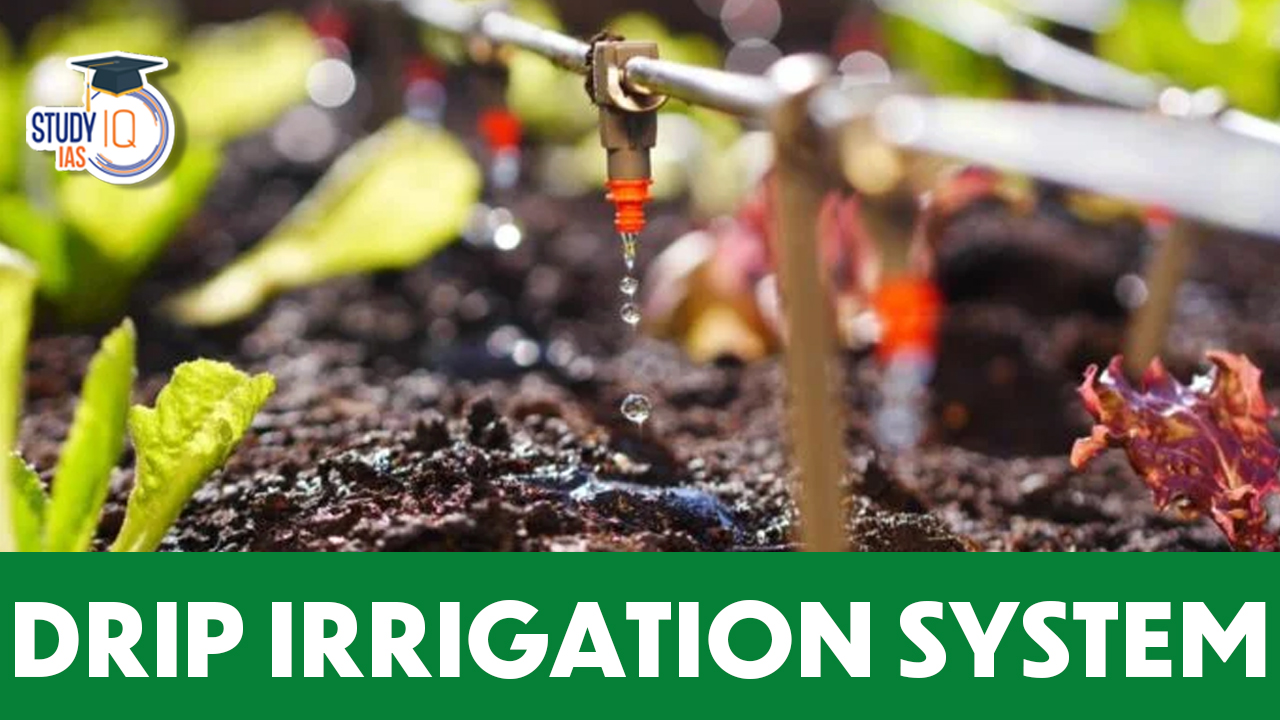Table of Contents
Drip Irrigation System
In today’s changing agricultural world, efficient and sustainable irrigation methods are essential. With water becoming scarcer and food demand increasing, techniques like drip irrigation are becoming important. Drip irrigation delivers water directly to plant roots, conserving water, improving crop yields, and reducing environmental impact. This article explores the different aspects of drip irrigation.
Read about: World Environment Day
What is Drip Irrigation System?
The Drip Irrigation system is a type of irrigation system where water is delivered directly to the roots of plants through small tubes and emitters, ensuring precise and efficient water usage, minimizing wastage, and promoting optimal plant growth.
Read about: Tropical Climate
Drip Irrigation System Components
The various components of a drip irrigation system typically include:
| Components | Details |
| Water Source | The source from where water is drawn for irrigation, such as a well, pond, or reservoir. |
| Pump | A device used to pressurize the water and provide the necessary flow rate for the system. |
| Filter | Removes debris, sediment, and other impurities from the water to prevent clogging of the emitters and ensure the smooth functioning of the system. |
| Mainline | The primary pipeline that carries water from the water source to the irrigation area. |
| Submain | Smaller pipelines branching off from the mainline, distributing water to different zones or sections of the field. |
| Emitters | Devices that release water in controlled amounts directly to the plant root zone. This can include drippers, micro-sprinklers, or micro-sprayers. |
| Lateral Lines | Tubes or pipes that deliver water from the submain to the individual plants or crop rows. |
| Fittings | Connectors, elbows, tees, and other components used to join different sections of the pipeline together. |
| Pressure Regulator | Maintains a consistent and optimal pressure level in the system, ensuring uniform water distribution. |
| Control Valve | Allows for manual or automated control of water flow and system operation. |
| End Caps | Used to seal the ends of lateral lines, preventing water leakage. |
| Flush Valves | Openings or devices that facilitate the flushing of the system to remove any accumulated sediments or debris. |
| Monitoring and Control System | Optional components such as sensors, timers, and controllers that enable precise control and monitoring of the irrigation system. |
These components work together to create an efficient and effective drip irrigation system, delivering water directly to the plants in a controlled manner, maximizing water efficiency, and promoting healthy plant growth.
Read about: Heat Zones of Earth
How to Install a Drip Irrigation System?
Installing a drip irrigation system involves several steps. Here is a general guide on how to install a drip irrigation system:
- Plan and Design: Assess your irrigation needs, including the area to be irrigated, water source, and plant requirements. Design the layout of the system, considering the location of plants, water pressure, and water flow requirements.
- Gather Materials: Purchase all the necessary components for your drip irrigation system, including pipes, emitters, fittings, valves, filters, and any additional accessories required.
- Prepare the Area: Clear the area where the irrigation system will be installed, removing any obstructions or vegetation.
- Install Mainline and Submain: Lay out the mainline and submain pipes according to your design. Connect them to the water source, using appropriate fittings and connectors. Ensure proper alignment and secure the pipes firmly in place.
- Install Lateral Lines: Attach the lateral lines to the submain, positioning them close to the plants. Install emitters or micro-sprinklers along the lateral lines, following the spacing guidelines based on the plants’ water requirements.
- Install Valves and Filters: Install control valves and filters at appropriate locations in the system to regulate water flow and remove debris or sediments that could clog the emitters.
- Test the System: Before covering the pipes, test the system by turning on the water supply. Check for any leaks, observe water distribution, and make any necessary adjustments to the emitters or sprinklers.
- Secure the System: Once the system is working properly, bury the pipes or cover them with mulch to protect them from damage and reduce evaporation.
- Regular Maintenance: Periodically inspect the system for leaks, clogs, or damaged components. Clean filters as needed and make adjustments based on plant growth and changing water requirements.
Read about: Continental Drift Theory
Advantages of Drip Irrigation System
Drip irrigation systems offer several advantages over traditional irrigation methods. Here are some of the key advantages of drip irrigation:
- Water Efficiency: Drip irrigation delivers water directly to the plant roots, minimizing evaporation, runoff, and water wastage. It can achieve high water use efficiency, typically using 30-50% less water compared to other irrigation methods.
- Improved Plant Health: Drip irrigation provides a consistent and precise water supply to plants, ensuring they receive the necessary moisture without waterlogging. It promotes healthier root development, reduces weed growth, and minimizes diseases associated with excessive moisture.
- Reduced Weed Growth: By delivering water only to the plant root zone, drip irrigation helps reduce weed growth. It minimizes moisture availability in the areas between plants where weeds often thrive.
- Fertilizer Efficiency: Drip systems allow for the precise application of fertilizers directly to the root zone, reducing nutrient losses through leaching or evaporation. This enhances fertilizer efficiency and reduces environmental pollution.
- Soil Erosion Control: Drip irrigation applies water gently and in controlled amounts, reducing soil erosion caused by heavy irrigation or runoff. It helps maintain soil structure, prevents nutrient leaching, and promotes better soil health.
- Versatility and Adaptability: Drip irrigation can be adapted to various topographies, soil types, and crop layouts. It is suitable for both small-scale and large-scale farming and can be used for various crops, including field crops, vegetables, orchards, and gardens.
- Energy Efficiency: Drip irrigation systems operate at low pressure, requiring less energy for water pumping compared to other irrigation methods like sprinklers or flood irrigation.
- Labour Savings: Once installed, drip irrigation systems require minimal manual intervention. They automate the watering process, reducing the need for frequent monitoring and manual labour.
- Scalability and Precision: Drip irrigation systems can be easily expanded or modified to accommodate changes in crop patterns or field layouts. They provide precise control over water application, allowing for tailored irrigation based on individual plant needs.
- Environmental Benefits: By conserving water, reducing chemical runoff, and minimizing soil erosion, drip irrigation contributes to environmental sustainability and the conservation of natural resources.
Disadvantages of Drip Irrigation System
While drip irrigation systems offer numerous advantages, they also have a few disadvantages to consider. Here are some of the common disadvantages associated with drip irrigation:
- High Initial Cost: The initial installation cost of a drip irrigation system can be relatively higher compared to traditional irrigation methods. The cost includes purchasing materials, emitters, filters, valves, and installing the system components.
- System Complexity: Drip irrigation systems can be complex to design and install, requiring technical knowledge and expertise. Proper planning and layout are essential to ensure uniform water distribution and avoid issues such as clogging or emitter malfunction.
- Maintenance Requirements: Drip irrigation systems require regular maintenance to ensure proper functioning. Emitters can get clogged by debris or mineral deposits, necessitating frequent cleaning or replacement. Filters may need periodic cleaning or replacement as well.
- Susceptible to Damage: Drip irrigation components, such as tubes and emitters, can be susceptible to damage from rodents, insects, or accidental human interference. Physical damage can result in leaks or disrupt water flow, affecting the system’s performance.
- System Design Challenges: Designing a drip irrigation system requires careful consideration of factors such as soil type, topography, plant spacing, and water pressure. Inadequate design or improper layout may lead to uneven water distribution or insufficient coverage.
- Limited Water Flow: Drip systems operate at relatively low pressure, which can limit the flow rate of water compared to other irrigation methods. This may impact the system’s ability to provide sufficient water in certain situations, such as during peak water demand or for high water-consuming crops.
- Susceptibility to Clogging: Drip irrigation systems are prone to clogging, especially if the water source contains sediments, debris, or high levels of minerals. Clogged emitters can disrupt water flow, reduce uniformity, and require regular maintenance to ensure optimal performance.
- Dependency on Water Quality: The quality of the water used in a drip irrigation system is crucial. Water with high salinity or chemical content can lead to salt accumulation in the soil, affecting plant health and system performance. Water quality testing and appropriate water treatment may be necessary.
Read about: Mountain Ranges
Scheme of Government of India for Drip Irrigation System
The Government of India has introduced several schemes to promote and support the adoption of drip irrigation systems. Some of the prominent schemes include:
Pradhan Mantri Krishi Sinchayee Yojana (PMKSY)
This scheme aims to enhance water use efficiency in agriculture by promoting various irrigation technologies, including drip irrigation. PMKSY provides financial assistance to farmers for installing drip irrigation systems and offers subsidies on equipment and components.
National Mission on Micro Irrigation (NMMI)
Under this mission, the government encourages the adoption of micro irrigation systems, including drip irrigation, by providing financial support for farmers. The scheme offers subsidies and assistance for the installation, training, and capacity building related to micro-irrigation technologies.
Rashtriya Krishi Vikas Yojana (RKVY)
RKVY promotes sustainable agriculture practices and modern irrigation techniques, including drip irrigation. The scheme provides financial support to states for implementing projects related to irrigation infrastructure development, including the installation of drip irrigation systems.
Pradhan Mantri Fasal Bima Yojana (PMFBY)
PMFBY provides insurance coverage and financial support to farmers in case of crop loss or damage due to natural calamities. The scheme incentivizes farmers to adopt efficient irrigation methods such as drip irrigation, which can reduce the risk of crop failure.
State-specific Initiatives
Various states in India have also launched their own schemes and initiatives to promote drip irrigation. For example, Andhra Pradesh has implemented the “Andhra Pradesh Micro Irrigation Project” to encourage the use of micro irrigation systems, including drip irrigation, with subsidized rates and financial assistance to farmers.
Read about: Rivers of India
Drip Irrigation System UPSC
The topic of drip irrigation systems is important for the UPSC (Union Public Service Commission) examination as it aligns with the syllabus of subjects like Agriculture, Environment, and Ecology. Understanding the concepts and significance of drip irrigation is crucial for aspirants preparing for the UPSC exam, as it covers aspects related to sustainable agriculture, water resource management, and environmental conservation. Knowledge of the drip irrigation system and its advantages, along with relevant government schemes, can help candidates tackle questions related to agricultural practices, water management, and government initiatives. Studying this topic through UPSC Online Coaching and attempting UPSC Mock Test can enhance candidates’ understanding on such topics.
Read about: Indian Ocean


 Goods and Services Tax (GST), Objectives...
Goods and Services Tax (GST), Objectives...
 World Oceans Day 2025, History, Theme, S...
World Oceans Day 2025, History, Theme, S...
 World Environment Day 2025, Theme, Histo...
World Environment Day 2025, Theme, Histo...





















